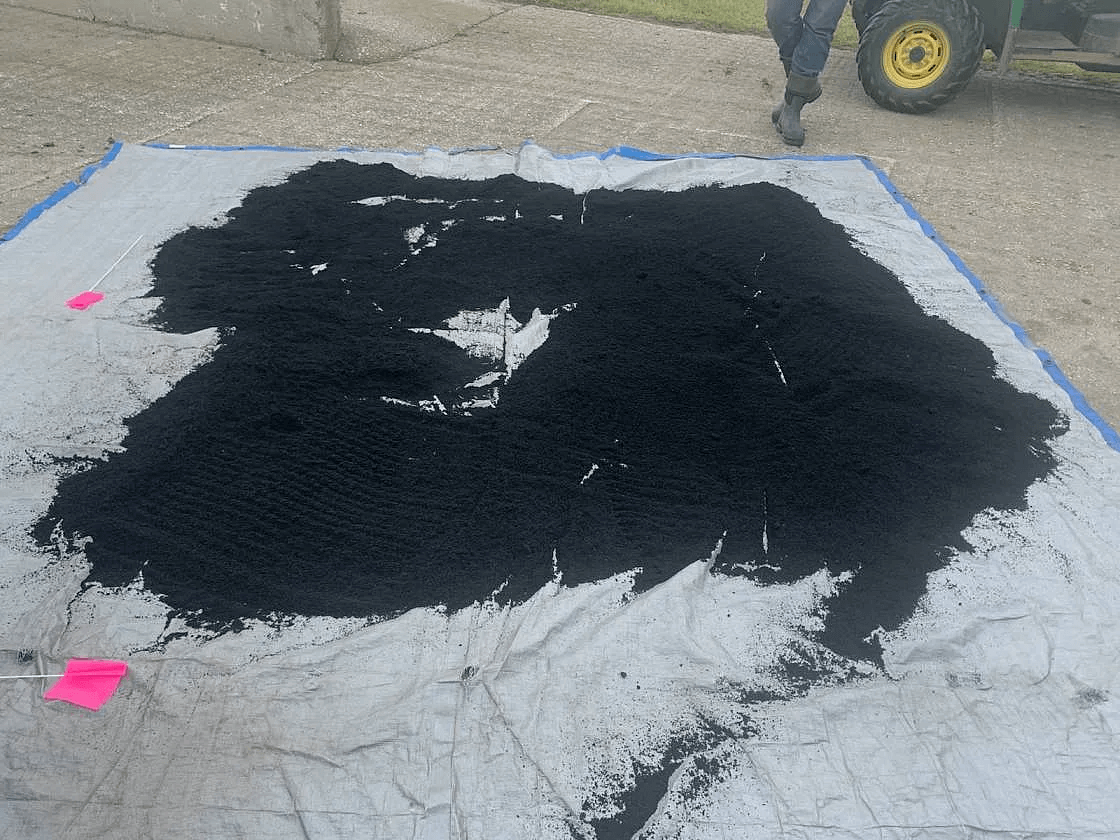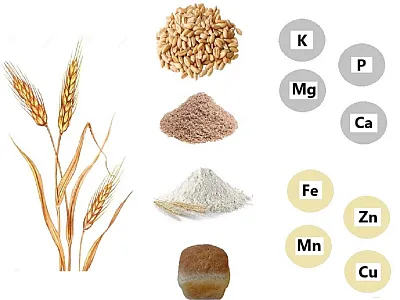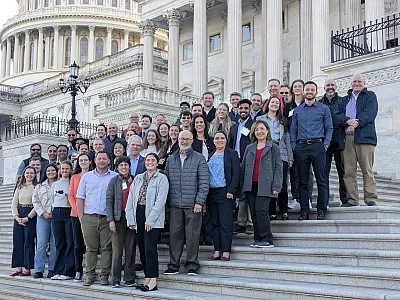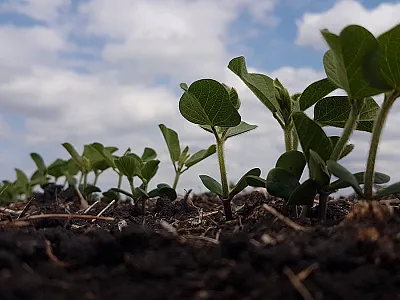Does applying biochar suppress emissions from manure applications?


Many farmers are interested in reducing greenhouse gas emissions from manure application to reduce agriculture’s impact on global climate change. They don’t want costly nutrients volatizing into the atmosphere or running off into waterways. Excess nutrients can cause eutrophication of waterways—degradation from excess nutrients. A 2023 University of Vermont study found that application of biochar before liquid dairy manure both injected and broadcast released about 50% less nitrous oxide (N2O) than manure application alone. This finding is based on only one season of results so far, at one location. The research team is awaiting results from the repetition of the study on fresh plots on the same farm. Earn 0.5 CEUs in Sustainability by reading this article and taking the quiz.
A 2023 University of Vermont (UVM) study found that application of biochar before liquid dairy manure both injected and broadcast released about 50% less nitrous oxide (N2O) than manure application alone.
Lead researcher Carol Adair, associate professor in the Rubenstein School of Environment and Natural Resources at UVM, cautions that this finding is based on only one season of results so far, at one location. The research team is awaiting results from the repetition of the study in 2024 on fresh plots on the same farm. They also continued to monitor the 2023 plots to see if one application of biochar continues to reduce N2O emissions in the second year.
The experiment occurred on Borderview Farm in Alburgh, VT, literally across a dirt road from the Canadian border in the northwest corner of the state.
The researchers found no positive or negative effect of biochar on corn silage yield.

Importance of soil management in greenhouse gas emissions
Agricultural soil management produces 75% of U.S. N2O emissions. “Nitrous oxide is almost 300 times more effective at trapping heat in the atmosphere than carbon dioxide, so every little bit really matters,” Adair says.
Many farmers are interested in reducing greenhouse gas (GHG) emissions from manure application as well as the loss of nutrients through volatilization into the atmosphere or runoff into waterways. Excess nutrients can cause eutrophication of waterways—degradation from excess nutrients. Borderview Farm lies on a peninsula that juts into Lake Champlain, which is eutrophying.
When soils are relatively dry and oxygen is available, N2O comes from metabolism by soil microbes of ammonium into nitrate for energy. When soils are very wet and oxygen is low, most N2O comes from denitrification in which microbes use nitrate to metabolize carbon for energy.

Long-sought good news, with some caveats
This is the first bit of good news for farmers out of Adair’s lab since she began experimenting with ways to reduce GHG emissions from manure applications almost 10 years ago. Adair; Heather Darby, agronomic and soils extension specialist with UVM; and, most recently, master’s student Sophia Rubien have collaborated with Roger Rainville, owner of Borderview Farm, on a series of experiments seeking to find ways farmers could reduce their GHG emissions while still land-applying liquid dairy manure.
They first studied emissions with manure injection but found large pulses of N2O release shortly after application, especially when the soil was wet. Then they tried cover crops to see if that would reduce GHG emissions related to manure application, but that was also a failure. They killed the cover crop prior to applying manure and planting, as farmers would, and this added carbon to the soil, which increases denitrification and adds to N2O emissions.
Next, the lab’s luck turned with the 2023 biochar study. The study had four replicates each of eight treatments: broadcast manure application, injected manure application, fertilizer, and control, all with and without biochar. Biochar reduced N loss by 4 lb/ac when broadcast and 9 lb/ac when injected.

The team is excited to find something that seems to work to reduce N2O emissions with manure application, but there are a few caveats.
The biggest caveat is that biochar is expensive. The UVM team purchased from Wakefield Biochar in Georgia, which markets biochar as an organic garden amendment. The team applied biochar at the rate of 17 tons/ac. Because of biochar cost, each of 16 biochar-treated plots was only 10 ft by 50 ft, for a total of 0.18 acres of biochar-treated area. (Non-biochar-treated plots were 20 ft by 50 ft.) The team needed nine bags of biochar—each 2 yd3—which cost $2,700, not including shipping. This was a bulk rate discounted by 25%.
A ton of biochar costs $1,200–$1,600, so the biochar rate applied in this study would cost more than $20,000/ac. The effect would “have to last a lot of years” at that rate, Darby says. Even at $100–$200/ac, she continues, if farmers are not seeing a crop response or getting paid for emissions reduction—and they’re not—biochar supplementation is unlikely to happen.
“We’re constantly looking for ways for farmers to better utilize nutrients and reduce loses, especially nitrogen,” Darby says.
“There’s evidence that biochar suppresses emissions from manure, but we don’t yet know how to make the use of biochar practical and economically effective.”
Another caveat is that the team found that when manure was not applied along with the biochar, N2O emissions increased substantially, and the same happened when chemical fertilizer was applied with biochar. They’re not sure yet why those effects happened.
Still another caveat is that the soils in Vermont last year were extremely wet. So it’s unclear whether the GHG results will repeat in a more typical weather year.
Shelburne Farms applies biochar directly to manure pit
About 50 miles south of Alburgh and on the eastern shore of Lake Champlain, Shelburne Farms is “an education nonprofit on a mission to inspire and cultivate learning for a sustainable future.” On its working dairy farm, staff have used biochar with their manure pit since 2020 (but not in 2021), hoping for odor and GHG emissions control. They also hoped biochar would function as a soil amendment and help the farm meet its goal to be carbon negative by 2028.
Among other livestock, the farm has about 110 Brown Swiss dairy cows, from which they produce milk and cheese. Farm staff broadcast-apply liquid dairy manure, but odor is a constant concern.
The 1,400-acre Shelburne Farms property includes a restaurant and accommodates overnight guests in several guesthouses and a 24-room country estate. They also have walking paths and educational activities accessible by donation.
The farm has used biochar from three different suppliers, including the same supplier—Standard Biocarbon in Maine—for the last two years. Sam Dixon, dairy farm manager at Shelburne Farms, says it’s the best biochar they’ve used. It’s purpose-made biochar, not a by-product.
Shelburne Farms paid about $140/yd3 delivered for 100 yd3 of biochar in May 2024. The regular price is about $200/yd3. The goal was to have a floating mass on top of the manure pit to keep the pit from getting crusty and to reduce odors and emissions. Dixon reports that the biochar is very effective for odor control from the pit although they have not measured emissions of GHGs or compounds that give manure its odor.
Paul Stanley, the nutrient management professional who works with Shelburne Farms, reports that the biochar is most effective at controlling odors from the pit itself and during and after land application but not as effective when the tank is agitated before manure is loaded into trucks for application.
Shelburne Farms staff hope to continue to research the effects of biochar with manure application.
Where to go from here?
Adair’s team is looking for a partner that is making biochar as a by-product of another process, so it may be less expensive. Darby notes that some farmers in the Northeast already use wood ash as a soil supplement. Wood ash is a by-product of wood-burning power plants, so it might serve essentially the same purpose as biochar but at a much more reasonable price of about $30–$40/ton delivered. Darby says wood ash provides potassium and a liming effect. Future studies could examine the properties of wood ash versus biochar and compare their effectiveness in controlling GHG emissions with manure application.
If the results from 2024 continue to be promising, the team hopes to do more studies on more farms. The type of soil may be important in this treatment. The 2023 study took place on Benson rocky silt loam.
Other future studies could determine the lowest rate of biochar that yields the desired benefits, how often biochar must be applied to maintain those benefits, and how biochar is best applied. There’s also interest in further research on biochar for manure odor control and soil health and in different climates. Farmers want to know if they’d be able to apply less N fertilizer if they apply biochar.
The research was supported through Ben and Jerry’s Homemade, Inc.
Self-study CEU quiz
Earn 0.5 CEUs in Sustainability by taking the quiz for the article at https://web.sciencesocieties.org/Learning-Center/Courses. For your convenience, the quiz is printed below. The CEU can be purchased individually or you can access as part of your Online Classroom Subscription.
- In the 2023 University of Vermont study, what effect did biochar have on corn silage yield?
- A positive effect.
- No effect.
- A negative effect.
- Corn silage yield was not measured.
- When soils are dry and oxygen is available, where does soil N2O come from?
- Conversion of nitrate into N2 gas by microbes.
- Eutrophication.
- Metabolism of ammonium into nitrate by soil microbes.
- Metabolism of carbon into N2 gas by microbes.
- Agricultural soil management produces what percentage of U.S. N2O emissions?
- 9%.
- 25%.
- 50%.
- 75%.
- In the 2023 University of Vermont study, biochar reduced N loss by ___ in broadcast and ___ in injection.
- 4 lb/ac, 9 lb/ac
- 9 tons/ac, 4 tons/ac
- 9 lb/ac, 4 lb/ac
- 12 lb/ac, 16 lb/ac
- Wood ash may serve the same purpose as biochar but has the drawback of being more expensive.
- True.
- False.
Text © . The authors. CC BY-NC-ND 4.0. Except where otherwise noted, images are subject to copyright. Any reuse without express permission from the copyright owner is prohibited.










